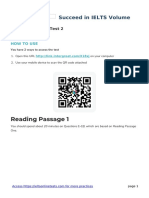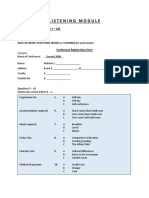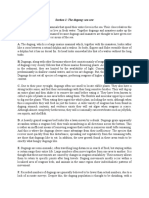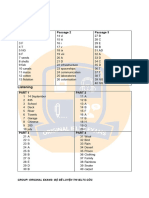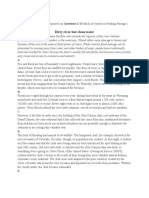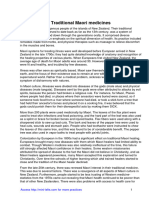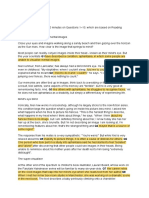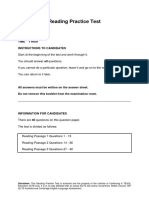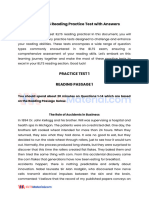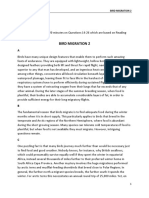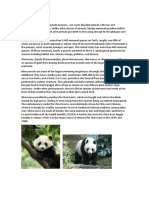Koala Fact Sheet: Status
Koala Fact Sheet: Status
Uploaded by
Raul RoncallaCopyright:
Available Formats
Koala Fact Sheet: Status
Koala Fact Sheet: Status
Uploaded by
Raul RoncallaOriginal Title
Copyright
Available Formats
Share this document
Did you find this document useful?
Is this content inappropriate?
Copyright:
Available Formats
Koala Fact Sheet: Status
Koala Fact Sheet: Status
Uploaded by
Raul RoncallaCopyright:
Available Formats
KOALA FACT SHEET
STATUS:
Vulnerable.
DESCRIPTION:
Koalas have soft, wool-like fur that is gray above and white
below. Their fur is mostly white on the underside below the
neck, and their ears have long white hairs on the tips. The
koala resembles a bear, but is actually a marsupial, a special
kind of mammal which carries its young in a pouch.
SIZE:
Koalas are rather small, round animals. They weigh about 30
pounds and on average grow to be 2 feet tall.
POPULATION:
There are fewer than 100,000 koalas.
LIFESPAN:
Koalas can live as long as 17 years, although high mortality
rates (due to car fatalities and dogs) for males lower their life
expectancy to 2 to 10 years.
RANGE:
The koala's historic range stretches across Australia. Today
they can be found only in Queensland, New South Wales,
Victoria, and South Australia.
HABITAT:
Koalas prefer to live in eucalyptus forests, coastal islands, and
low woodlands.
FOOD:
Koalas consume eucalyptus leaves and bark from 12 different
eucalyptus tree species. They also consume mistletoe and
box leaves.
BEHAVIOR:
Nocturnal mammals, koalas sleep for up to 16 hours a day. They are arboreal, which means that they live in trees. They
do not live in big groups but rather prefer to be alone. Females are solitary and occupy distinct home ranges that they
rarely leave. In the more fertile areas, these ranges overlap; in areas where suitable food trees are scarce they tend to be
larger and more exclusive. Males are not territorial, but do not tolerate one another, particularly not during the breeding
season: dominant individuals attack subordinate ones, and most adult males carry scars on their face, ears and forearms
as a result.
The koala is almost entirely arboreal. It does not make nests, but sleeps in a tree fork or on a branch. It climbs using its
powerful claws for grip, usually moving quite slowly but can climb rapidly when needed.
The koala will leap confidently from one tree to another if they are reasonably close together. Its climbing is aided by a
pair of thumbs on each paw, and it is the only other animal aside from primates to possess fingerprints. Longer distances
are traversed on the ground in a slow but effective waddle. If threatened, the koala breaks into a surprisingly athletic
gallop, heading for the nearest tree and bounding up it to a safe height. There the koala waits for the intruder to go away
with the patience of a creature that routinely sleeps for 18 hours a day. The koala is also rather adept at swimming.
OFFSPRING:
Koalas breed once a year. Gestation lasts 35 days, after which one koala is born. A baby koala is referred to as a joey
and is hairless, blind, and earless. At birth the joey, only the size of a jelly bean, crawls into the downward facing pouch on
the mother's belly (which is closed by a drawstring like muscle that the mother can tighten at will) and attaches itself to
one of the two teats. Young remain hidden in the pouch for about six months, only feeding on milk. During this time they
grow ears, eyes, and fur. The joey then begins to explore outside of the pouch. At about 30 weeks it has begun to eat the
semi liquid form of the mothers excrement called "pap". The baby koala will remain with the mother for another six
months or so, riding on her back, and feeding on both milk and gum leaves until weaning is complete at about 12 months
of age. Young females disperse to nearby areas at that time; young males often stay in the mother's home range until
they are two or three years old.
THREATS:
Once numbering in the millions, koalas suffered major declines in population during the 1920s when they were hunted for
their fur. Today, habitat destruction, traffic deaths, and attacks by dogs kill an estimated 4,000 koalas yearly. The koala
was hunted almost to extinction in the early 20th century. In recent years, some colonies have been hard hit by disease,
especially chlamydia. The koala requires large areas of healthy, connected forest and will travel long distances along tree
corridors in search of new territory and mates. The ever increasing human population of the coastal parts of the continent
continues to cut these corridors by agricultural and residential development, forestry and road building, marooning koala
colonies in decreasing areas of bush. The Australian Koala Foundation has mapped 40,000 km of land for koala habitat
and claims it has strong evidence to suggest wild koala populations are in serious decline throughout the species' natural
range. Although the species covers a massive area, only 'pieces' of Koala habitat remain. These pieces need to be
managed, protected and restored in a coordinated way. Presently, many are being lost to weeds, cleared for agriculture,
or carved up by developers. Other threats come from logging, poor management, attacks from feral and domestic
animals, disease and roads.
In contrast to the situation on much of the mainland, where populations are declining, the koalas of many island and
isolated populations have reached what some have described as "plague" proportions. On Kangaroo Island in South
Australia, koalas introduced some 90 years ago have thrived in the absence of predators and competition. Combined with
an inability to migrate to new areas, this has caused the koala populations to become unsustainable and threaten the
Island's unique ecology. In particular, species of Manna Gum, native to the island, are being stripped by koalas at a rate
faster than they can regenerate, endangering local birds and invertebrates that rely on them, and causing the extinction of
at least one isolated population of manna. Koala numbers are estimated at over 30,000, with ecologists suggesting that
the Island can sustain 10,000 at most. Although culling has been suggested as a means to reduce koala numbers, this
has met with fierce opposition both domestically and internationally, and the species remains protected. The popularity of
the koala has made the possibility of a cull politically improbable, with any negative perception likely to impact on tourism
and a government's electability. In place of a cull, sterilization and translocation programs have had only limited success
in reducing numbers thus far, and remain expensive. There is evidence that koalas relocated to the mainland have
difficulty establishing themselves in the different circumstances. A mooted alternative to the complex sterilization method,
wherein the animal must first be captured, are hormonal implants that can be injected via darts.
CAPTIVITY:
While zoos and aquariums may appear to be educational and conservation-oriented, most are designed with the needs
and desires of the visitors in mind, not the needs of the animals. Many animals in zoos and aquariums exhibit abnormal
behavior as a result of being deprived of their natural environments and social structures. Some zoos and aquariums do
rescue some animals and work to save endangered species, but most animals in zoos were either captured from the wild
or bred in captivity for the purpose of public display, not species protection. The vast majority of captive-bred animals will
never be returned to the wild. When the facility breeds too many animals they become "surplus" and often are sold to
laboratories, traveling shows, shooting ranches, or to private individuals who may be unqualified to care for them.
PROTECTION:
Australian national laws protect koalas, but each individual state is responsible for the animal's conservation.
You might also like
- @mindless WriterDocument4 pages@mindless Writerjavohirakmalov2No ratings yet
- Reading Passage 1: Succeed in IELTS Volume 11Document16 pagesReading Passage 1: Succeed in IELTS Volume 11Anonymous RPGElSNo ratings yet
- Reading Practice Cambridge 17 Test 3Document13 pagesReading Practice Cambridge 17 Test 3sidikNo ratings yet
- 08 Passage 1 - Otter Q1-13Document5 pages08 Passage 1 - Otter Q1-13Cương Nguyễn DuyNo ratings yet
- PRE Test ReadingDocument10 pagesPRE Test ReadingAnak komunikasi BangetNo ratings yet
- The CACAO A Sweet HistoryDocument48 pagesThe CACAO A Sweet HistoryIbrahim KhleifatNo ratings yet
- Ielts Reading ExerciseDocument3 pagesIelts Reading ExerciseTạThanhHiềnNo ratings yet
- IELTS Listening 25 Real Exam TestDocument1 pageIELTS Listening 25 Real Exam TestHarsh vaghelaNo ratings yet
- Ielts Exam PaperDocument15 pagesIelts Exam PaperSrinivasan candbNo ratings yet
- IELTS Reading Easy Test 71-84Document42 pagesIELTS Reading Easy Test 71-84Võ Thành Hiệp100% (1)
- Reading PracticeDocument3 pagesReading PracticeUyên Hoàng100% (1)
- Section 1: The Dugong: Sea CowDocument11 pagesSection 1: The Dugong: Sea CowKelvin100% (1)
- Test 1'Document9 pagesTest 1'721k0060No ratings yet
- Diabetes Ielts Reading AnswersDocument2 pagesDiabetes Ielts Reading AnswersMohammed AbdallahNo ratings yet
- Reading IELTS Vol 2 Test 1Document11 pagesReading IELTS Vol 2 Test 1Minh TàiNo ratings yet
- KEY PDFDVDDDocument2 pagesKEY PDFDVDDMarufNo ratings yet
- IELTS Test ReadingDocument8 pagesIELTS Test ReadingzFortunate zNyoniNo ratings yet
- Living DunesDocument41 pagesLiving DunesbethuyanNo ratings yet
- Test 5Document12 pagesTest 5Hiền Cao MinhNo ratings yet
- 15 Passage 2 - Activities For Children Q14-26Document6 pages15 Passage 2 - Activities For Children Q14-26Cương Nguyễn DuyNo ratings yet
- IELTS Reading Practice 2Document9 pagesIELTS Reading Practice 2nhung phanNo ratings yet
- 22 Passage 2 - Western Immigration of Canada Q14-26Document6 pages22 Passage 2 - Western Immigration of Canada Q14-26Cương Nguyễn DuyNo ratings yet
- Chocolate PassageDocument4 pagesChocolate PassageYaseen AlladinNo ratings yet
- IELTS Recent Actual Test With Answers Volume 5Document15 pagesIELTS Recent Actual Test With Answers Volume 5Binh Pham ThanhNo ratings yet
- 90 Connector-Stories CanDocument11 pages90 Connector-Stories CanJustoNo ratings yet
- Traditional Maori MedicinesDocument5 pagesTraditional Maori MedicinesKEERTHANA KNo ratings yet
- Reading Passage 3-20.5Document5 pagesReading Passage 3-20.5JaydenNo ratings yet
- Section 1 Questions 1-13Document13 pagesSection 1 Questions 1-13ielts Ice GiangNo ratings yet
- Mocktest 3 ReadliswrtDocument19 pagesMocktest 3 ReadliswrtĐức TrungNo ratings yet
- Real Exam PaperDocument4 pagesReal Exam PaperJoshua JethrohNo ratings yet
- TEST 4 Reading Actual TestsDocument42 pagesTEST 4 Reading Actual Testshoabeo1984No ratings yet
- IELTS Reading Practice Test Raining OnlineDocument16 pagesIELTS Reading Practice Test Raining Onlinebhiman bajarNo ratings yet
- Day 8 Passage 3Document4 pagesDay 8 Passage 3Huseynov SardorNo ratings yet
- IELTS Reading Practice Test 5 - Vol 6Document14 pagesIELTS Reading Practice Test 5 - Vol 6Thu but biNo ratings yet
- Reading Ielts 23.11Document3 pagesReading Ielts 23.11Phan HaNo ratings yet
- Reading Passage 3Document20 pagesReading Passage 3Preet SharmaNo ratings yet
- Test 1 ReadDocument8 pagesTest 1 ReadHạnh Nguyên Trần NguyễnNo ratings yet
- IELTS Reading Easy Test 61-70Document31 pagesIELTS Reading Easy Test 61-70Võ Thành HiệpNo ratings yet
- Reading Passage 1Document4 pagesReading Passage 1Hiền Cao MinhNo ratings yet
- Foot Pedal Irrigation: Reading 1 Section 1Document18 pagesFoot Pedal Irrigation: Reading 1 Section 1Amandeep KaurNo ratings yet
- Reading Practice Test v5Document14 pagesReading Practice Test v5hachanNo ratings yet
- IELTS Reading Recent Practice Test 2023Document34 pagesIELTS Reading Recent Practice Test 2023MaxmudNo ratings yet
- 08 Passage 2 - BIRD MIGRATION 2 Q14-26Document6 pages08 Passage 2 - BIRD MIGRATION 2 Q14-26Cương Nguyễn DuyNo ratings yet
- Reading Passage 1: Test 16 DiabetesDocument7 pagesReading Passage 1: Test 16 DiabetesRavi ZaiminNo ratings yet
- Readingpracticetest4 v7 524Document14 pagesReadingpracticetest4 v7 524Mada SolimanNo ratings yet
- Going Bananas: Checkboxes & Related Question TypesDocument7 pagesGoing Bananas: Checkboxes & Related Question TypesTUTOR IELTSNo ratings yet
- HardDocument4 pagesHardAnh ThưNo ratings yet
- 13 Passage 2 - Tasmanian Tiger Q14-26Document7 pages13 Passage 2 - Tasmanian Tiger Q14-26Cương Nguyễn DuyNo ratings yet
- Ipp Ielts - Read - Test 49Document7 pagesIpp Ielts - Read - Test 49Cúc NguyễnNo ratings yet
- 13 Passage 1 - Learning by Examples Q1-13Document5 pages13 Passage 1 - Learning by Examples Q1-13Cương Nguyễn DuyNo ratings yet
- Test 2Document12 pagesTest 2Hiền Cao MinhNo ratings yet
- 22 Passage 1 - Origin of Species - Continent Formation Q1-13Document6 pages22 Passage 1 - Origin of Species - Continent Formation Q1-13Cương Nguyễn DuyNo ratings yet
- Se Reading Vol 3Document112 pagesSe Reading Vol 3My NguyễnNo ratings yet
- 17 Passage 3 - The Exploration of Mars Q27-40Document7 pages17 Passage 3 - The Exploration of Mars Q27-40Cương Nguyễn DuyNo ratings yet
- 03 Passage 2 - Antarctica - in From The Cold Q14-26Document6 pages03 Passage 2 - Antarctica - in From The Cold Q14-26Cương Nguyễn DuyNo ratings yet
- Explanation - 8Document3 pagesExplanation - 8Gia Huy NguyenNo ratings yet
- KoalaDocument3 pagesKoalaEmita DalingNo ratings yet
- Koala Facts - All About KoalasDocument4 pagesKoala Facts - All About KoalasAmira BerbićNo ratings yet
- MammalsDocument9 pagesMammalsrovel shelieNo ratings yet
- All Things Koalas For Kids: Filled With Plenty of Facts, Photos, and Fun to Learn all About Koala BearsFrom EverandAll Things Koalas For Kids: Filled With Plenty of Facts, Photos, and Fun to Learn all About Koala BearsNo ratings yet

